Investigation of Heat Transfer Fluids Using a Solar Concentrator for Medium Temperature Storage Receiver Systems and Applications
Abstract
1. Introduction
2. Methodology
2.1. Performance Parameters of Solar Concentrator
2.1.1. Optical Performance
2.1.2. Thermal Performance
2.2. Characteristic Parameters of Heat Transfer Fluid
2.2.1. Heating Test
2.2.2. Cooling Test
2.3. Storage Receiver System
3. Designing of the Solar Dish Concentrator
3.1. Paraboloidal Structure
3.2. Tracking
3.3. Receiver
4. Selection of HTFs
5. Experimental Study
5.1. Test Set-Up
5.2. Thermal Profiles
6. Result and Discussion
6.1. Thermal Performance of the Developed Concentrator
6.2. Characteristics of HTFs
7. Conclusions
Author Contributions
Funding
Acknowledgments
Conflicts of Interest
Nomenclature
| α | absorption coefficient of the absorber |
| γ | reflected radiation fraction at the receiver surface |
| sun shape error (°) | |
| instant thermal efficiency | |
| θ | angle of incidence on the horizontal surface (°) |
| ρ | specular reflectance of the concentrator |
| τ | transmittance of receiver cover material |
| τc | cooling time characteristic (s) |
| rim angle (°) | |
| dish aperture area (m2) | |
| receiver base area (m2) | |
| Ars | receiver total surface area (m2) |
| Cc | concentration ratio |
| Cf | specific heat of fluid at the constant pressure (J/kg°C) |
| Cr | specific heat of receiver (J/kg°C) |
| D | concentrator diameter (m) |
| Fw | focal image width (m) |
| Fpw | practical focal image width (m). |
| f | focal distance (m) |
| h | height (m) |
| Ib | beam radiation at dish aperture area (W/m2), |
| Is | global solar insolation on horizontal surface (W/m2), |
| Kγτα | incidence angle modifier |
| mr | receiver mass (kg) |
| mf | fluid mass (kg) |
| qa | rate of available heat (W). |
| qu | rate of utilizable heat (W) |
| ql | rate of heat loss (W) |
| r | local mirror radius (m) |
| Rh | heating rate of HTF (°C/s) |
| Rc | cooling rate of HTF (°C/s) |
| Tf | fluid temperature (°C) |
| Tfm | maximum fluid temperature (°C) |
| Tnf | normalized maximum fluid temperature (°C) |
| Tr | receiver temperature (°C) |
| Ta | ambient temperature (°C) |
| ΔTf | rise in fluid temperature in the Δt time interval (°C) |
| UL | overall heat loss coefficient (W/mK), |
| CSP | concentrated solar power |
| EG | ethylene glycol |
| EO | engine oil |
| HTF | heat transfer fluid |
| LDR | light-dependent resistor |
| SO | silicone oil |
| SPDC | solar paraboloidal dish concentrator |
| STC | solar thermal collector |
| STS | solar thermal systems |
| SRS | storage receiver system |
| TES | thermal energy storage |
References
- Duffie, J.A.; Beckman, W.A. Solar Energy Thermal Processes; New York John Willy and Sons: Hoboken, NJ, USA, 1974. [Google Scholar]
- Boerema, N.; Morrison, G.; Taylor, R.; Rosengarten, G. Liquid sodium versus Hitec as a heat transfer fluid in solar thermal central receiver systems. Sol. Energy 2012, 86, 2293–2305. [Google Scholar] [CrossRef]
- Mahavar, S.; Bhardwaj, A.; Dashora, P. Fabrication and testing of a light weight solar concentrator. Int. J. Solid State Mater. 2016, 2, 1–9. [Google Scholar]
- Mahavar, S.; Khan, M.S.; Yadav, T. Synthesis, Characterization and Testing of Black Metal Oxide Nanoparticles as Solar Concentrator Receiver Material. Mater. Today Proc. 2019, 8, 22–27. [Google Scholar] [CrossRef]
- Benoit, H.; Spreafico, L.; Gauthier, D.F. Review of heat transfer fluids in tube receivers used in concentrating solar thermal systems: Properties and heat transfer coefficients. Renew. Sustain. Energy Rev. 2016, 55, 298–315. [Google Scholar] [CrossRef]
- Vignarooban, K.; Xu, X.; Arvay, A.; Hsu, K.; Kannan, A.M. Heat transfer fluids for concentrating solar power systems-A review. Appl. Energy 2015, 146, 383–396. [Google Scholar] [CrossRef]
- Malviya, R.; Agrawal, A.; Baredar, P.V. A Comprehensive review of different heat transfer working fluids for solar thermal parabolic trough concentrator. Mater. Today Proc. 2021, 46 Pt 11, 5490–5500. [Google Scholar] [CrossRef]
- Zaharil, H.A.; Hasanuzzaman, M. Modelling and Performance Analysis of Parabolic Trough Solar Concentrator for Different Heat Transfer Fluids under Malaysian Condition. Renew. Energy 2020, 149, 22–41. [Google Scholar] [CrossRef]
- Conroy, T.; Collins, M.N.; Fisher, J.; Grimes, R. Thermohydraulic analysis of single phase heat transfer fluids in CSP solar receivers. Renew. Energy 2018, 129 Pt A, 150–167. [Google Scholar] [CrossRef]
- Trabelsi, S.E.; Qoaider, L.; Guizani, A. Investigation of using molten salt as heat transfer fluid for dry cooled solar parabolic trough power plants under desert conditions. Energy Convers. Manag. 2018, 15, 253–263. [Google Scholar] [CrossRef]
- Kenda, E.S.; Edem, K.; Tsoukpoe, N.; Igor, W.K.O.; Coulibaly, Y.; Xavier, P.; Marie, F.; Armel, W. Jatropha curcas crude oil as heat transfer fluid or thermal energy storage material for concentrating solar power plants. Energy Sustain. Dev. 2017, 40, 59–67. [Google Scholar] [CrossRef]
- Hoffmann, J.F.; Vaitilingom, G.; Henry, J.F.; Chirtoc, M.; Olives, R.; Goetz, V. Temperature dependence of thermophysical and rheological properties of seven vegetable oils in view of their use as heat transfer fluids in concentrated solar plants. Sol. Energy Mater. Sol. Cells 2018, 178, 129–138. [Google Scholar] [CrossRef]
- Nkwetta, D.N.; Smyth, M.; Zacharopoulos, A.; Hyde, T. Experimental performance analysis and optimization of medium temperature solar thermal collectors with silicon oil as a heat transfer fluid. Int. J. Energy Res. 2013, 37, 570–581. [Google Scholar] [CrossRef]
- Jung, C.; Dersch, J.; Nietsch, A.; Senholdt, M. Technological Perspectives of Silicone Heat Transfer Fluids for Concentrated Solar. Power Energy Procedia 2015, 69, 663–671. [Google Scholar] [CrossRef]
- Peng, Q.; Ding, J.; Wei, X.; Yang, J. The Preparation and Properties of Multi-Component Molten Salts. Appl. Energy 2010, 87, 2812–2817. [Google Scholar] [CrossRef]
- Qoaider, L.; Thabit, Q.; Kiwan, S. Innovative Sensible Heat Transfer Medium for a Moving Bed Heat Exchanger in Solar Central Receiver Power Plants. Appl. Sol. Energy 2017, 53, 161–166. [Google Scholar] [CrossRef]
- Perez-Tavernier, J.; Vallejo, J.P.; Cabaleiro, D.; Fernandez-Seara, J.; Lugo, L. Heat transfer performance of a nano-Enhanced propylene glycol:water mixture. Int. J. Therm. Sci. 2019, 139, 413–423. [Google Scholar] [CrossRef]
- Sandhya, J.; Venkatraj, V. Effect of various heat transport fluids on central receiver solar thermal power plant. Mater. Today Proc. 2019, 16 Pt 2, 314–320. [Google Scholar]
- Quederni, A.R.E.; Salah, M.B.; Askri, F.; Nasrallah, M.B.; Aloui, F. Experimental study of a parabolic solar concentrator. Revue des Energies Renouvelables 2009, 12, 395–404. Available online: https://www.cder.dz/download/Art12-3_6.pdf.
- Mohammed, I.L. Design and development of a parabolic dish solar water heater. Int. J. Eng. Res. Appl. 2012, 2, 822–830. [Google Scholar]
- Omara, Z.M.; Eltawil, M.A. Hybrid of solar dish concentrator, new boiler and simple solar collector for brackish water desalination. Desalination 2013, 326, 62–68. [Google Scholar] [CrossRef]
- Subramani, J.; Nagarajan, P.K.; Subramaniyan, C.; Anbuselvan, N. Performance studies on solar parabolic dish collector using conical cavity receiver for community heating applications. Mater. Today Proc. 2021, 45 Pt 2, 1862–1866. [Google Scholar] [CrossRef]
- Hassan, A.; Quanfang, C.; Abbas, S.; Lu, W.; Youming, L. An experimental investigation on thermal and optical analysis of cylindrical and conical cavity copper tube receivers design for solar dish concentrator. Renew. Energy 2021, 179, e1849–e1864. [Google Scholar] [CrossRef]
- Mahavar, S.; Goyal, A.; Balakin, B.V. Investigation of a Solar Concentrator for Water Distillation. In Advances in Thermal Engineering, Manufacturing, and Production Management. ICTEMA 2020. 2021. Lecture Notes in Mechanical Engineering; Ghosh, S.K., Ghosh, K., Das, S., Dan, P.K., Kundu, A., Eds.; Springer Nature Singapore Pte Ltd.: Singapore. [CrossRef]
- Kumar, V.; Yadav, A. Experimental investigation of parabolic dish concentrator with various sizes of receiver. Mater. Today Proc. 2021, 44, 4966–4971. [Google Scholar] [CrossRef]
- Reddy, K.S.; Veershetty, G.; Vikram, T.S. Effect of wind speed and direction on convective heat losses from solar parabolic dish modified cavity receiver. Sol. Energy 2016, 131, 183–198. [Google Scholar] [CrossRef]
- Khandelwal, N.; Sharma, M.; Singh, O.; Shukla, A.K. Comparative analysis of the linear Fresnel reflector assisted solar cycle on the basis of heat transfer fluids. Mater. Today Proc. 2021, 38, 74–79. [Google Scholar] [CrossRef]
- Scott, W.; Paul, S.; Harold, P.; Ernest, S.E. Heat Transfer Properties of Engine Oils. In Proceedings of the WTC2005 World Tribology Congress III, Washington, DC, USA, 12–16 September 2005. [Google Scholar]
- Yue, H.; Zhao, Y.; Ma, X.; Gong, J. Ethylene glycol: Properties, synthesis, and applications. Chem. Soc. Rev. 2012, 41, 4218–4244. [Google Scholar] [CrossRef]
- Sathish, S.; Kannan, M.; Sathish, B.R.; Johnson, S.S.; Jacob, S. Experimental Analysis of Single Reflector Box Type Solar Cooker with Thermo Fluid. J. Crit. Rev. 2020, 7, 144–147. [Google Scholar] [CrossRef]
- Grirate, H.; Zari, N.; Elmchaouri, A.; Molina, S.; Couturier, R. Life Time Analysis of Thermal Oil Used as Heat Transfer Fluid in CSP Power Plant. AIP Conf. Proc. 2016, 1734, 040005. [Google Scholar] [CrossRef]
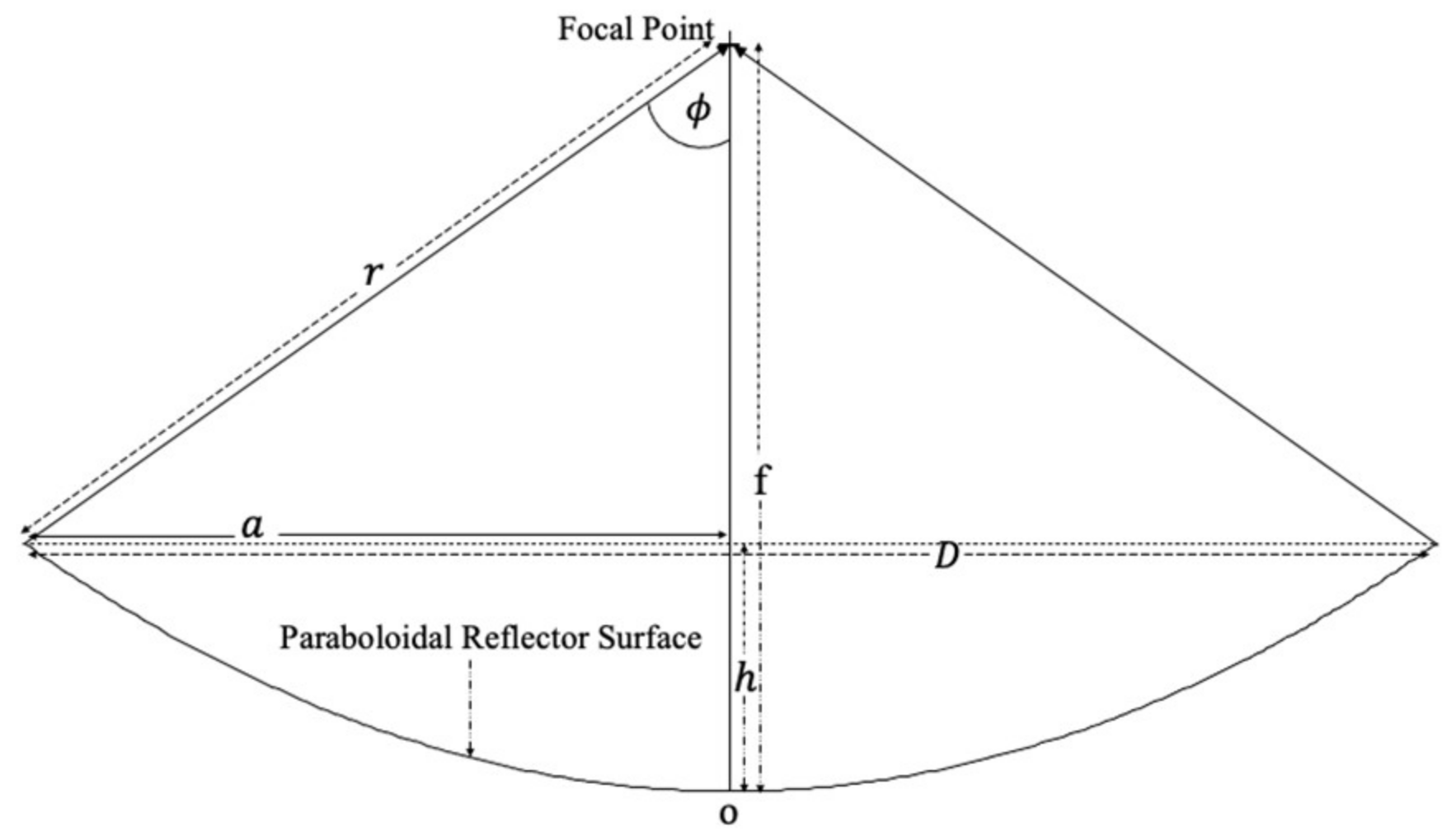
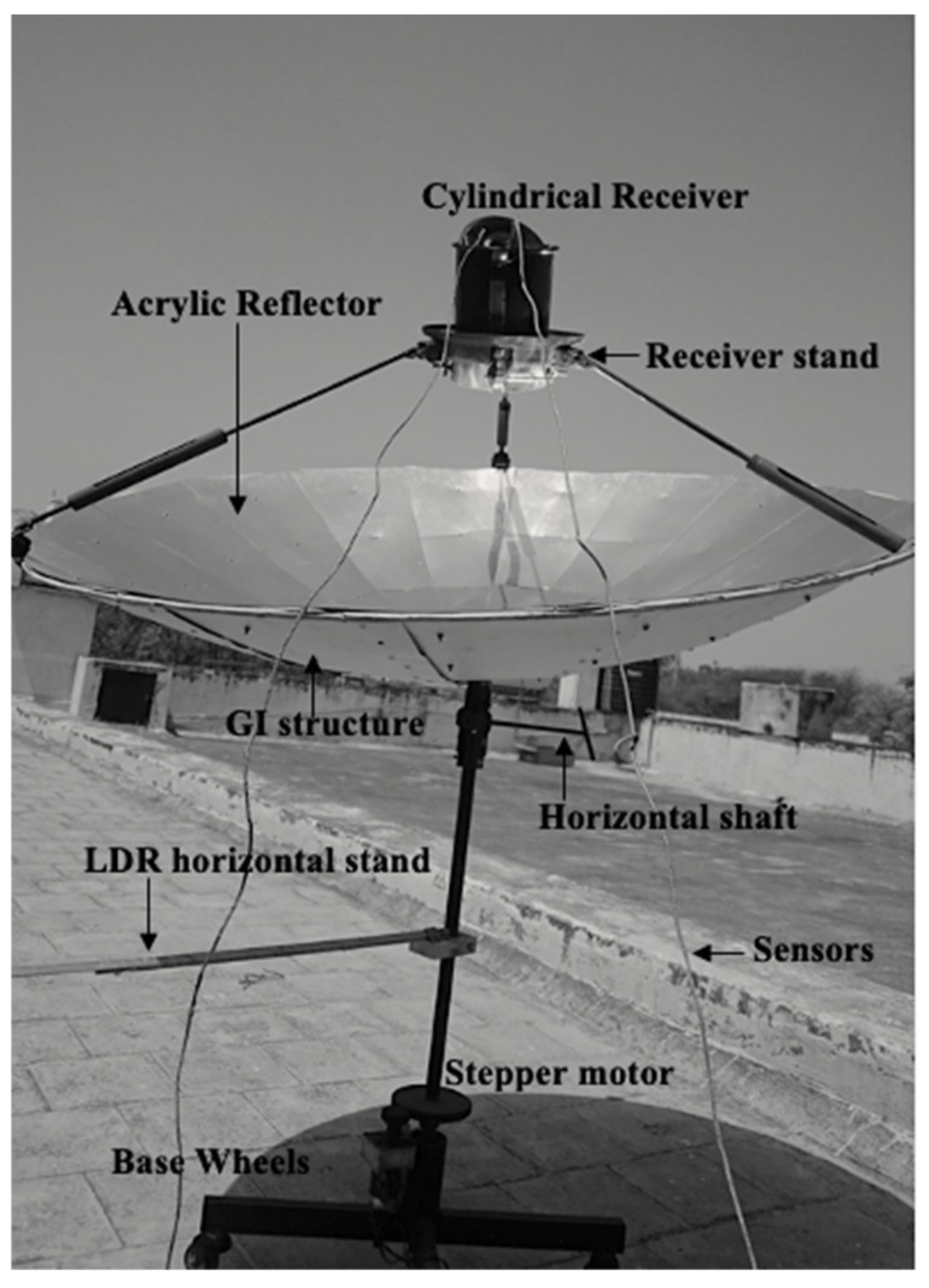
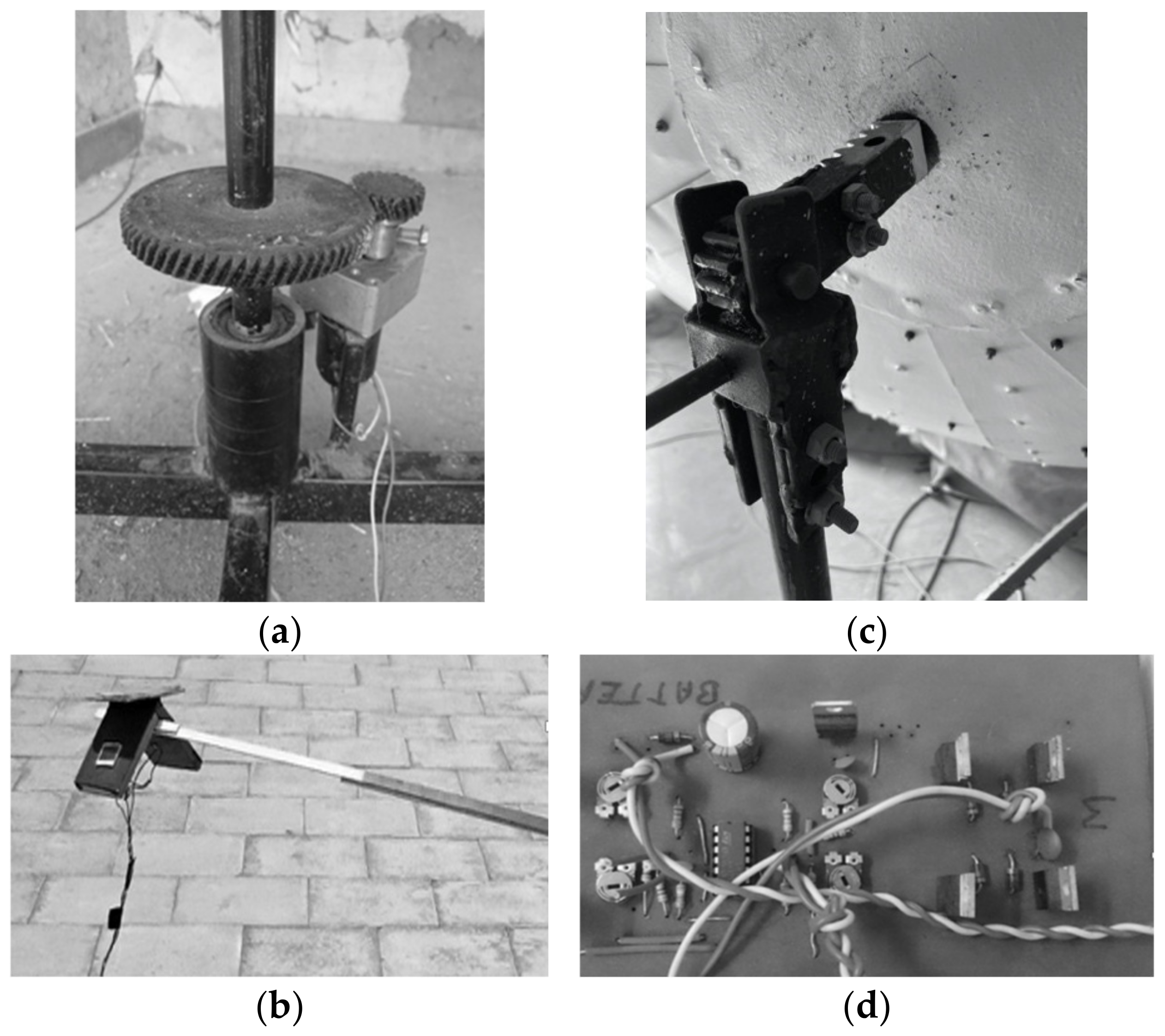
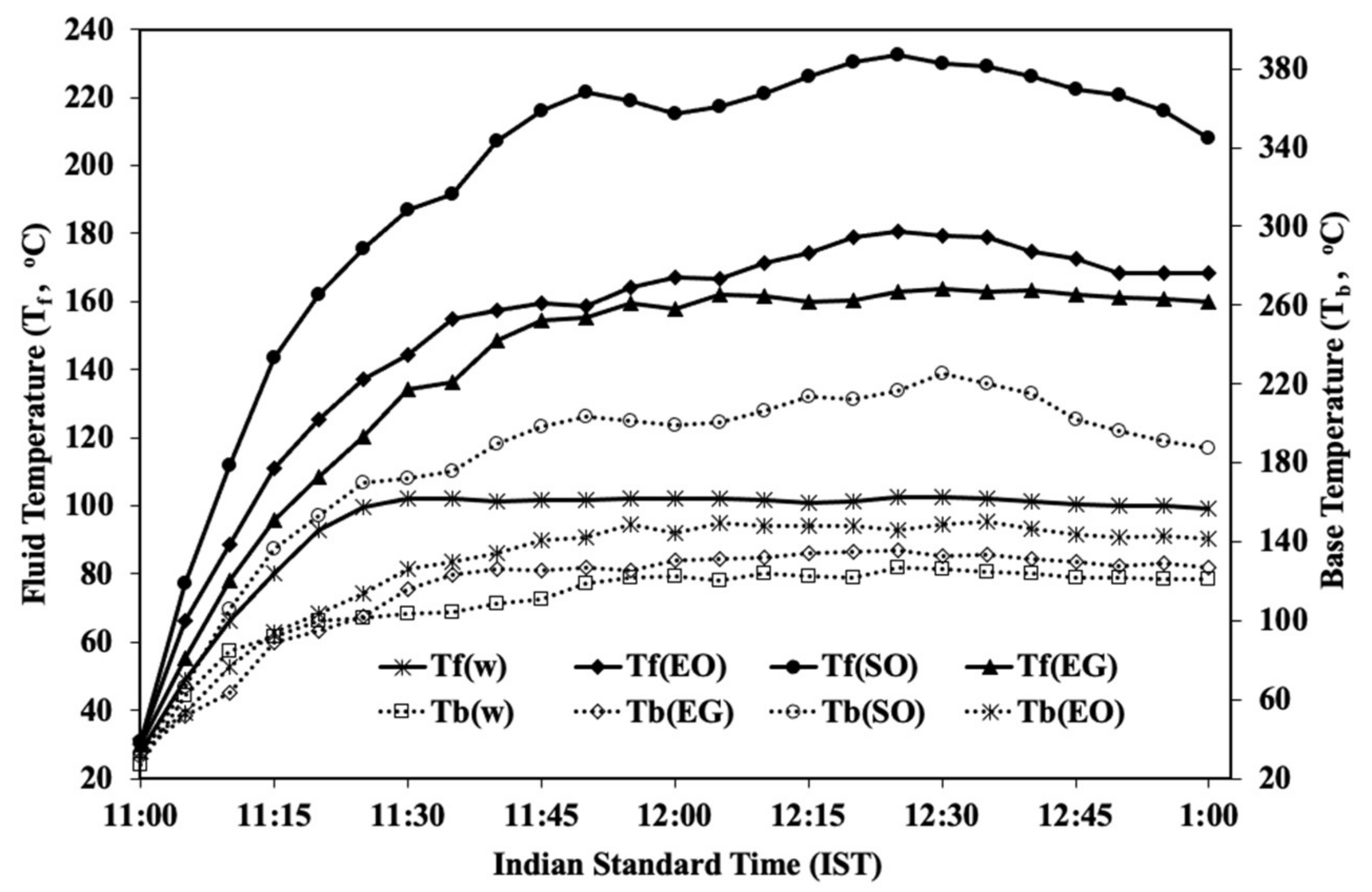
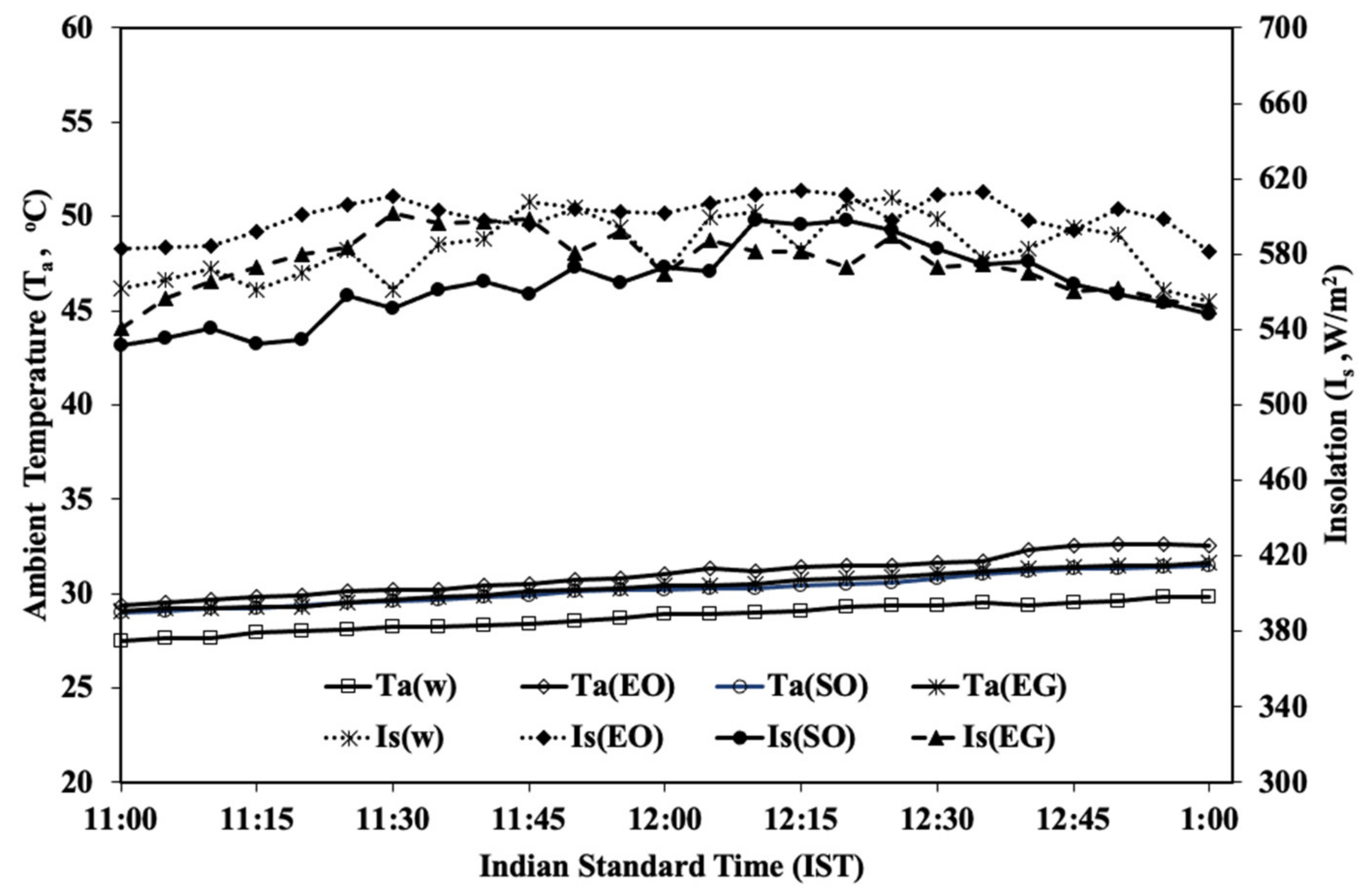
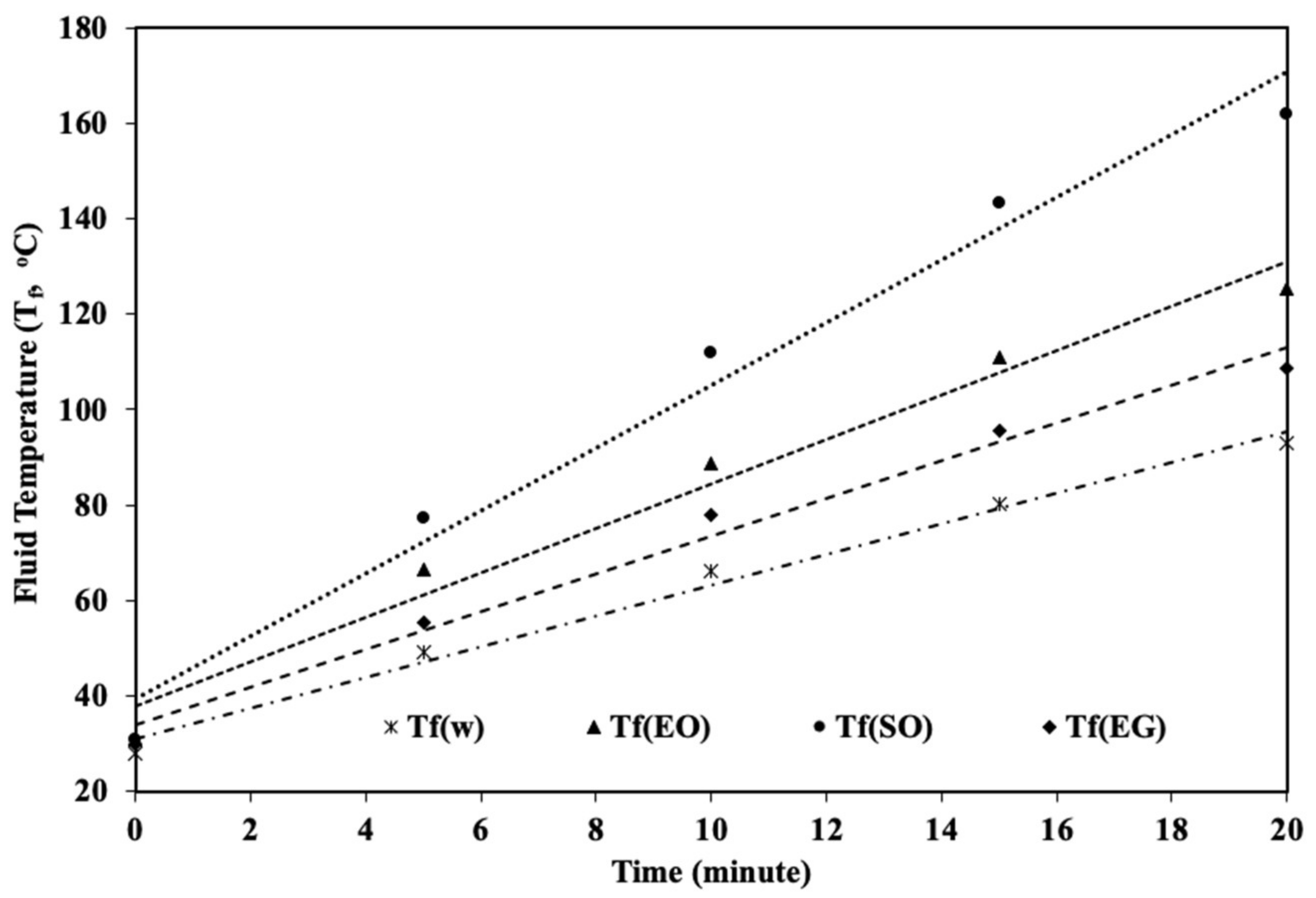
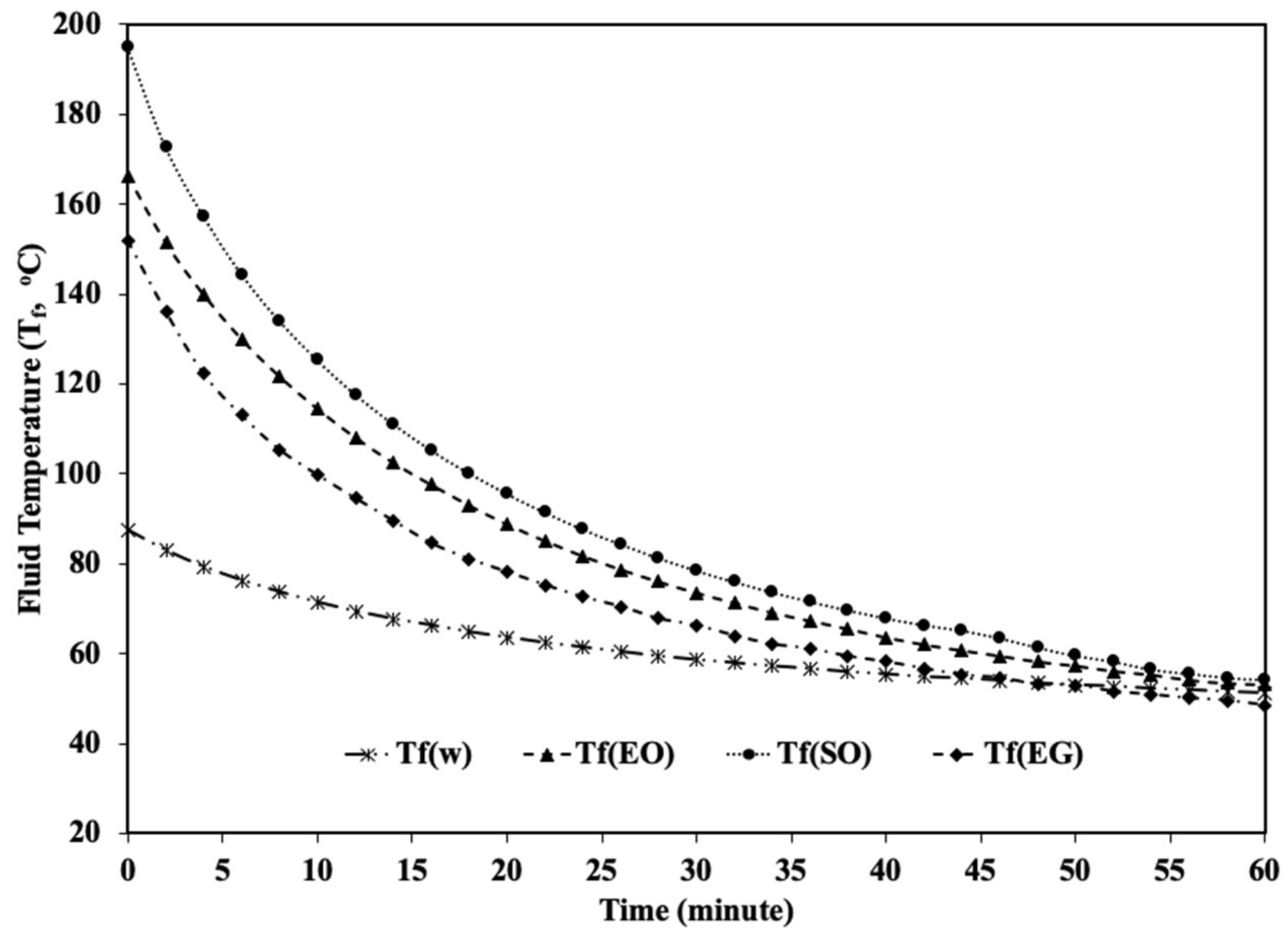
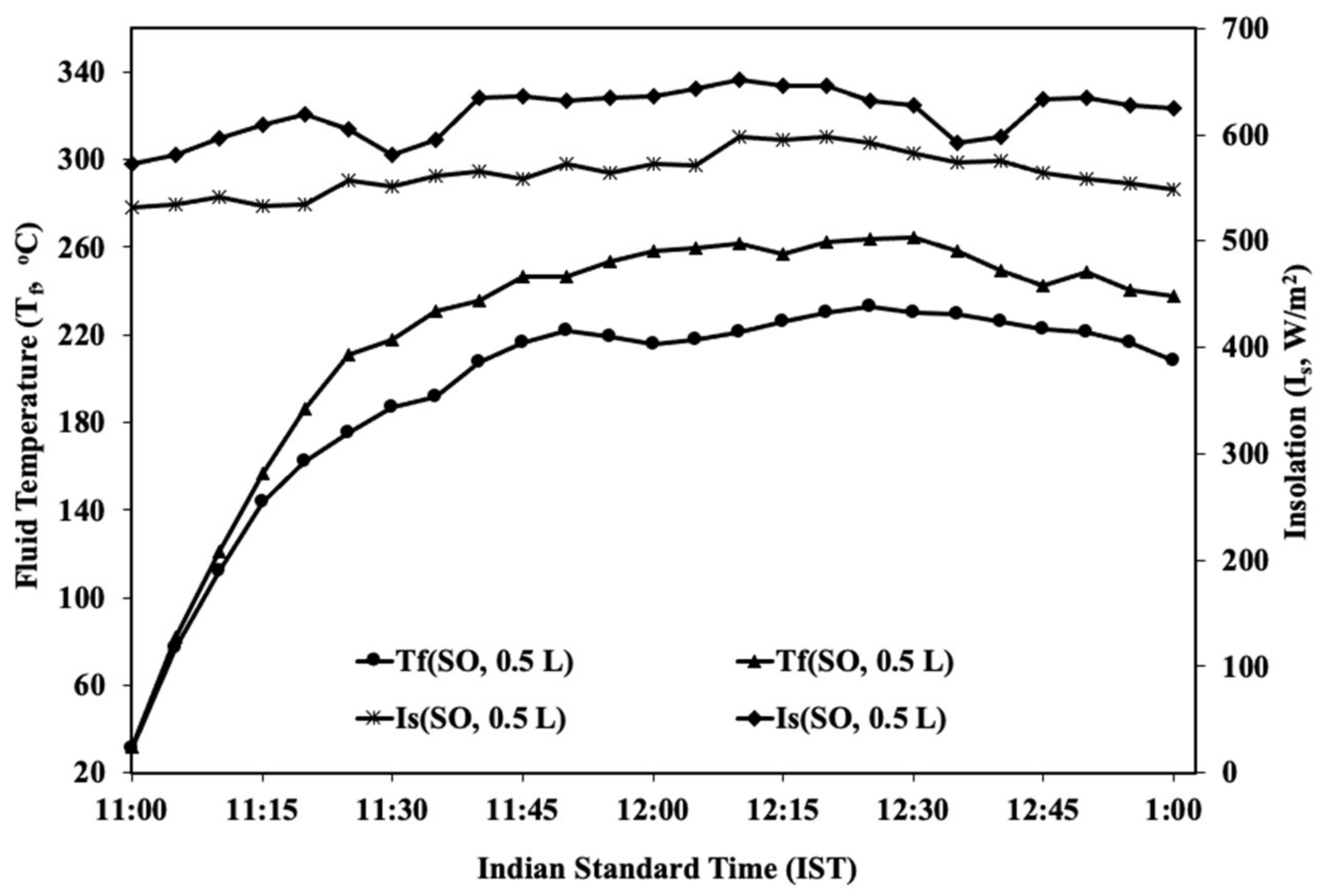
| Reference | Fluid | Solar Appliance | Application | Temperature (°C) |
|---|---|---|---|---|
| Boerema et al. [2] | Hitec and Liquid sodium (Na) | CSP | HTF | 585/873 |
| Trabelsi et al. [10] | Therminol VPI and Molten Salt | CSP | TES | 400/593 |
| Kenda et al. [11] | Jatropha curcas crude oil | CSP | HTF/TES | 210 |
| Hoffman et al. [12] | Seven vegetable oils | CSP | HTF | upto 250 |
| Nkwetta et al. [13] | Dow-corning 550 silicon oil | ETC (non-concentrating) | HTF | 67 |
| Jung et al. [14] | Silicone fluid (HELISOL® 5) | CSP | HTF | 450 |
| Peng et al. [15] | Molten salt | Property study | 550 | |
| Qoaidera et al. [16] | Mobiltherm 603 | CSP | HTF | 300 |
| Perez-Tavernier et al. [17] | Propylene glycol:water mixture (30:70% mass ratio) | ETC (non-concentrating) | HTF | Low temp. 50 |
| Jadhav and Venkatraj [18] | Liquid Sodium, Hitec XL and Steam | CSP | HTF | 600, 873 |
| Ref. | Dish Dimensions | Receiver Details | Thermal Parameters | ||||||
|---|---|---|---|---|---|---|---|---|---|
| Dia. (m) | Focal (m) | Height (m) | Material | Shape | Dia. (m) | Fluid | Efficiency (%) | Max. Temp. (°C) | |
| Ouederni et al. [19] | 2.2 | 0.75 | 0.4 | SS & copper | Dish | 0.12 | No | 27 | 375 |
| Mohammed [20] | 1.67 | 0.58 | 0.30 | Aluminium | Cylinderical | 0.14 | Water | 50 | 100 |
| Omara and Eltawil [21] | 1.0 | 0.40 | 0.20 | - | - | - | Brackish water | 34 | 101 |
| Subramani et al. [22] | 1.5 | 0.74 | 0.19 | Copper | Conical cavity | 0.008 | Water | 77 | 97 |
| Hassan et al. [23] | 1.0 | 1.02 | - | Copper | Cylindr-ical & Conical | 0.17 | Water | 59–62 | 80 |
| Mahavar et al. [24] | 1.21 | 0.45 | 0.20 | Copper | Cylindr-ical | Water with charcoal | - | 80 | |
| Kumar & Yadav [25] | 1.83 | 0.784 | - | Anodized Aluminium | Sheet | 0.15 | No | 309 | |
| Properties | Water | Silicone Oil | Engine Oil | Therminol 66 | Ethylene Glycol |
|---|---|---|---|---|---|
| Density (kg/m3 at 25 °C) | 1000 | 900 | 870 | 1008 | 1113 |
| Flash point (°C) | - | 315 | 238 | 184 | 126 |
| Auto ignition Temperature (°C) | - | 450 | >234 | 374 | 427 |
| Boiling point (°C) | 100 | >250 | >176 | 359 | 197 |
| Critical temperature (°C) | 374 | - | 434 | 569 | 446 |
| Kinematic Viscosity, cSt (100 °C) | 0.2938 | 10–1000 | 12.5–16 | 3.77 | 1.99 |
| Thermal Conductivity (20 °C) (mW/K) | 0.6 | 0.10 | 0.13 | 0.12 | 0.25 |
| Specific Heat (50 °C) (kJ/kg°C) | 4.186 | 1.7 | 2.1 | 2.1 | 2.4 |
| Toxicity | No | Low | Highly | Low | Highly |
| Environmental Hazards | Friendly | Moderate | High | Moderate | High |
| Approximate cost INR (per liter) | 30 | 800 | 200 | 3000 | 400 |
| Time (min) | Heat Transfer Materials | |||||||||||
|---|---|---|---|---|---|---|---|---|---|---|---|---|
| W | EG | EO | SO | W | EG | EO | SO | W | EG | EO | SO | |
| 0 | 389 | 374 | 403 | 368 | 160 | 103 | 145 | 159 | 41 | 31 | 36 | 43 |
| 5 | 392 | 385 | 404 | 370 | 130 | 82 | 91 | 120 | 33 | 27 | 23 | 32 |
| 10 | 396 | 398 | 405 | 374 | 105 | 59 | 91 | 108 | 27 | 21 | 23 | 29 |
| 15 | 388 | 403 | 410 | 369 | 95 | 53 | 59 | 64 | 25 | 15 | 14 | 17 |
| 20 | 395 | 401 | 416 | 370 | 51 | 64 | 49 | 47 | 13 | 13 | 12 | 13 |
| 25 | 403 | 404 | 420 | 386 | 20 | 10 | 29 | 39 | 5 | 6 | 7 | 10 |
| HTF | Heating Curve | Cooling Curve | |||||||
|---|---|---|---|---|---|---|---|---|---|
| Transient State | Steady State | Rc vs. (Tf − Ta) Curve | |||||||
| Rg | Rh (°C/s) | Tnf (°C) | Rg | ||||||
| Water | 0.99 | 3.21 | 41 | 101 | 588 | 120 | 0.96 | 17 | 26 |
| EG | 0.98 | 3.95 | 31 | 161 | 571 | 198 | 0.96 | 11 | 23 |
| EO | 0.98 | 4.66 | 36 | 173 | 603 | 200 | 0.98 | 15 | 15 |
| SO | 0.98 | 6.56 | 45 | 223 | 576 | 274 | 0.97 | 14 | 14 |
Publisher’s Note: MDPI stays neutral with regard to jurisdictional claims in published maps and institutional affiliations. |
© 2022 by the authors. Licensee MDPI, Basel, Switzerland. This article is an open access article distributed under the terms and conditions of the Creative Commons Attribution (CC BY) license (https://creativecommons.org/licenses/by/4.0/).
Share and Cite
Kuldeep, P.K.; Kumar, S.; Khan, M.S.; Panchal, H.; Mawire, A.; Mahavar, S. Investigation of Heat Transfer Fluids Using a Solar Concentrator for Medium Temperature Storage Receiver Systems and Applications. Energies 2022, 15, 7868. https://doi.org/10.3390/en15217868
Kuldeep PK, Kumar S, Khan MS, Panchal H, Mawire A, Mahavar S. Investigation of Heat Transfer Fluids Using a Solar Concentrator for Medium Temperature Storage Receiver Systems and Applications. Energies. 2022; 15(21):7868. https://doi.org/10.3390/en15217868
Chicago/Turabian StyleKuldeep, Pawan Kumar, Sandeep Kumar, Mohammed Saquib Khan, Hitesh Panchal, Ashmore Mawire, and Sunita Mahavar. 2022. "Investigation of Heat Transfer Fluids Using a Solar Concentrator for Medium Temperature Storage Receiver Systems and Applications" Energies 15, no. 21: 7868. https://doi.org/10.3390/en15217868
APA StyleKuldeep, P. K., Kumar, S., Khan, M. S., Panchal, H., Mawire, A., & Mahavar, S. (2022). Investigation of Heat Transfer Fluids Using a Solar Concentrator for Medium Temperature Storage Receiver Systems and Applications. Energies, 15(21), 7868. https://doi.org/10.3390/en15217868








